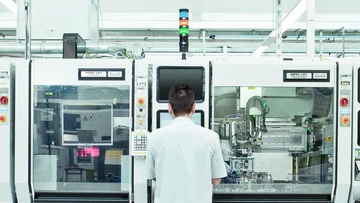MES and IIoT solutions from iTAC facilitate transparent, automated production workflows, building on the tried-and-tested manufacturing execution system iTAC.MES.Suite that combines various services for networking, automating and analysing production processes.
Integrated IoT/IIoT solutions add the finishing touches to iTAC’s MES, creating the basis for direct control of manufacturing processes and critical parameters, in order to trigger dynamic changes, keep the overall process stable and thus avoid errors.
The ability to easily link IIoT data, which relies on so-called unstructured data in the form of sensor data (e.g. vibration, temperature, etc.), with MES data to create flat data structures and to analyse this data in more or less real time, plays a central role. This is where iTAC’s new analytics features come in, enabling customers to quickly create individual use cases for their specific electronic and other manufacturing needs.
IoT integration gateway
One of the new iTAC products used to create IIoT use cases is the iTAC.IIoT.Hub. The hub can be used to merge data from sensors and from MES, for example, to form flat data packages and to sequence them in time. The data packages can then also be forwarded to the iTAC edge device or other analytics tools for analysis.
Edge-based analysis solution
iTAC offers an edge solution that enables data to be analysed in real time inside a company’s firewall for processes or machine states. Local data processing makes the edge solution a cost-effective alternative to cloud computing and unlocks performance benefits that can be critical within production control. With the help of a graphical analytics designer and the underlying rules engine, the user is able to create, configure and manage data flows without additional coding. The defined rules are then visualised in the iTAC.Workbench.
The visualisation contains information about the overall status and predictive error messages based on the analysis, and supports the optimisation of the defined rules. Additional notes and text can be displayed on the screen so that the user can decide more quickly what action is required to prevent problems from occurring. Clicking on the functions reveals more detailed information to the user. The view provides automatic mapping of process values that are relevant to the error situation, as well as historically similar data to enable comparisons with historical errors. The system can also automatically generate warnings and alarms to allow for a quick response when necessary.
Use case: product quality increased, failures reduced and much more
These two features are already in action in the first use cases. One of these presented the following challenge in the context of electronics manufacturing where the wave soldering process can become unstable even though it has been stable for x amount of time. The temperature of the PCB, the contact time with the liquid solder and the composition of the solder can vary greatly and, together, lead to soldering errors. iTAC supplied a streaming analytics solution to monitor this process. Sensors were retrofitted in a wave soldering machine, the gateway for sensor and MES data aggregation was integrated and the data analysed in real time. This resulted in more efficient service and maintenance, reduction of failures and downtime (from 2-3 failures per quarter to none), improved product quality, early warning of anomalies and faster response in the event of a fault (up 3 percent from 94 to 97 percent).


